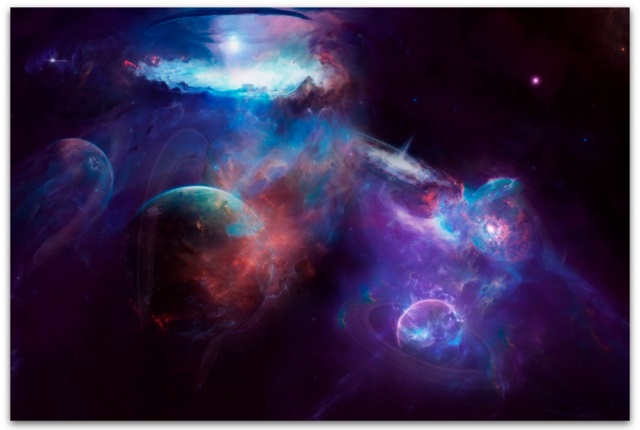
At some point the universe will die. That’s for sure. But when and how are questions that have interested scientists for decades.
Our universe was born 13.8 billion years ago in the Big Bang and has been expanding ever since. For some reason, a new empty space is created from nothing. The space itself is getting wider.
Will this process last forever or will it stop one day?
By all accounts, cosmic fate will be decided by the struggle between the “two titans” fighting for supremacy.
The first consists of two substances that exist in the universe: a) countless galaxies with stars, planets, asteroids, comets, dust and various other celestial objects; b) gas and c) dark matter.
Although they are very different from each other, they all want only one thing – to be attracted. Gravity pulls in all that matter and the cosmos as a whole, slowing the expansion that began with the big bang. Our second warrior is space.
Matter and energy
Although he looks empty and helpless, he has an inner energy. We have no idea what it is or why it even exists, but it has a special name – dark energy. It is a type of antigravity that accelerates cosmic expansion.
Therefore, all the matter that exists is trying to hold the universe together, while empty space imbued with dark energy is constantly pushing and expanding it. Depending on who wins, the universe will die in a different way.
Clash of the Titans
Physicists today know that dark energy fills 68.3% of the universe. Dark matter is second at 26.8%, and ordinary matter makes up only 4.9% of the total content of the universe. This ordinary matter includes everything we see in the universe, namely, all galaxies, stars, planets, and every grain of cosmic dust. This means that 95.1% of what makes up our universe not only cannot be seen, but cannot even be detected by any measuring device. Then the question arises, how do we know that dark matter and dark energy exist at all.
Before we look at the three possible scenarios for the death of the universe, let’s say something about these two mysterious phenomena.
Dark matter first became the subject of scientific research in the second half of the 20th century. Although we can’t see or touch it, its existence became evident in the 1930s, when Swiss astronomer Fritz Zwicky noticed that galaxy clusters had more mass than could be explained by ordinary matter. He concluded that there is “dark matter” that makes up most of the cluster’s mass, but this concept was not immediately accepted.
The real breakthrough came in the 1970s, when astronomers Vera Rubin and Kent Ford studied the rotations of spiral galaxies in detail. Their research showed that ordinary matter is not enough to explain the speed of these rotations. They therefore proposed the existence of an additional invisible mass that maintains the balance of gravitational forces.
There are several independent ways we can confirm the existence of dark matter. One of them is the analysis of the cosmic microwave background radiation, remnants of the big bang, and the other is the existence of the so-called gravitational lensing where the mass of dark matter bends the light of other objects in the universe.
In addition, simulations of the motion of galaxies and cosmic structures also contribute to the idea of the existence of dark matter. In other words, these simulations reproduce the observed phenomena only if we include dark matter.
On the other hand, the discovery of dark energy began with the observation of Type Ia supernovae, exploding stars that act as light markers of distance in space. Two independent research teams, the Supernova Cosmology Project and the High-Z Supernova Search Team, discovered in 1998 that the universe is expanding faster than expected. This strange phenomenon pointed to the existence of dark energy driving the acceleration.
In addition to supernovae, dark energy has been confirmed by other methods, such as the analysis of large galactic structures and the cosmic microwave background radiation.
It is truly fascinating that the fate of our universe is decided by the war of two phenomena that are completely mysterious and elusive to us. But back to the three possible scenarios for the ultimate fate of the universe.
The first is called “Big Freeze”. This will happen if dark energy wins in such a way that its strength remains constant.
The growth of the universe
As space grows, matter becomes more and more diluted, like sugar in a glass to which more and more tea is added. However, as the universe expands, more and more empty space is created, which in turn carries more and more dark energy that continues to separate matter, causing the universe to grow even faster. In fact, it is expanding at an exponential rate. Every 12 billion years it will double in diameter.
And while dark energy is winning the all-out war, matter is winning at least one battle. It can hold matter together, but only for short distances. For example, our Milky Way galaxy is located in a galaxy cluster called the Local Group. In it, apart from our galaxy, there are Andromeda (M31), Triangulum (M33) and eighty other galaxies and dwarf galaxies such as the Large and Small Magellanic Clouds.
The mutual gravity of all these galaxies can overcome the influence of dark energy. In a few billion years, the Local Group will merge into a giant ball of trillions of stars. Soon after, it will become our last glimpse of the universe. All other galaxies will be squeezed out by the expansion. To our distant descendants, it will appear as if the rest of the universe is drifting off into the distance, until in a few hundred billion years they will see no other galaxies at all. They will be alone, surrounded by a seemingly endless dark void.
In about a hundred billion years, all the stars in our supergalaxy will die out. All the gas that could have formed new stars will be used up. The galaxy will be dark and full of stellar corpses. Over billions of years, white dwarfs and neutron stars will slowly cool until they become black dwarfs.
All structures, large and small, will slowly disintegrate. One by one, all the dead stars and planets will leave the supergalaxy. This process will take trillions of years. Every subject will end up lonely. They will be as distant from each other as if each existed in its own universe. In a googol (10¹⁰⁰) years, the last black hole will evaporate.
After all, entropy and dark energy won’t stop until their work is done. Over even longer, virtually unimaginable, spans of time, any remaining structures might even dissolve into individual particles that would tear away from each other as the ever-increasing empty space. Imagine the entire universe with just one solitary particle traveling through nothingness.
Big tear
The second scenario is called “Big Rip”. In it, dark energy will not only win, but will further strengthen and literally tear apart the structure of space-time. In the great cooling, the substance wins some minor battles, but in the great tearing, it loses absolutely everything.
If the universe really ends that way, it could all start in 20 billion years.
First, dark energy will create empty space between individual galaxies. The Milky Way will leave the Local Group and begin to drift alone in the increasingly dark and rapidly inflating cosmos.
A few billion years later, the empty space begins to contract between individual stars, melting the galaxy. The night sky will start to look sad and dark as the other stars are pushed too far away for us to see.
A few million years after the sky darkens, dark energy begins to create empty space within the star systems themselves. Planets are pushed away from their parent stars so that all life in the universe freezes to death. There is not much time left because after only a few months dark energy creates empty space even in solid objects. Stars, planets, asteroids, everything solid… breaks into pieces.
Even if you were on a spaceship, within a day it too would disintegrate, and just half an hour later, even the atoms would be destroyed because new space would be created so fast that it could separate the electrons from the atomic nuclei.
In the final act, only black holes remain, exhausted and defeated by the exponentially growing dark energy. They would be tiny, a quadrillion times smaller than an atom. In a fraction of a second (10⁻³⁹), they would explode with the force of a billion supernovae.
And that’s it. Space-time has been torn apart, so it is completely impossible to predict what might happen next.
Nothing good
The third scenario is called Big Crunch
Finally an option where matter defeats dark energy. This would happen if the strength of dark energy decreases over time and if this decrease is strong enough for gravity to turn the war in its favor. Unfortunately for us, we don’t get anything good there either. Eventually, the universe would collapse in on itself. No one knows when it might start, but it could be in a few hundred million years.
As the universe begins to contract, over billions of years, galaxy clusters and galaxies themselves move closer together until they eventually merge. Then the stars themselves become closer to each other. At the same time, something else particularly terrible is happening.
Due to the shrinking of space, all the radiation that was emitted in the past by all the stars, supernovae and quasars that ever existed is concentrated. Space becomes so filled with radiation that space heats to enormous levels. As you know, the surface temperature of the Sun is about 5,500°C, and there are stars with a surface temperature of 30,000°C. In this scenario, however, the universe becomes so hot that even the stars literally burn from the outside.
Ultimately, the entire universe is condensed into a single point – the so-called singularity – from which our universe was created. There is even a possibility that after that there would be another big bang and the birth of a new universe.
The question arises: What is the most likely scenario?
It’s hard to say, but so far it seems that the first, big cooling, is our most likely future.
This seems sad, but it has one big advantage: in this scenario, the universe lasts the longest. We will have billions of years to expand and colonize not only the Milky Way, but possibly other galaxies as well. And who knows, maybe we’ll find a way to maintain consciousness forever.
However, we still have plenty of time to enjoy the secrets of our amazing universe. In fact, we have only just begun. Let’s be smart and solve all the problems on the planet so we can boldly go where no one has gone before.








